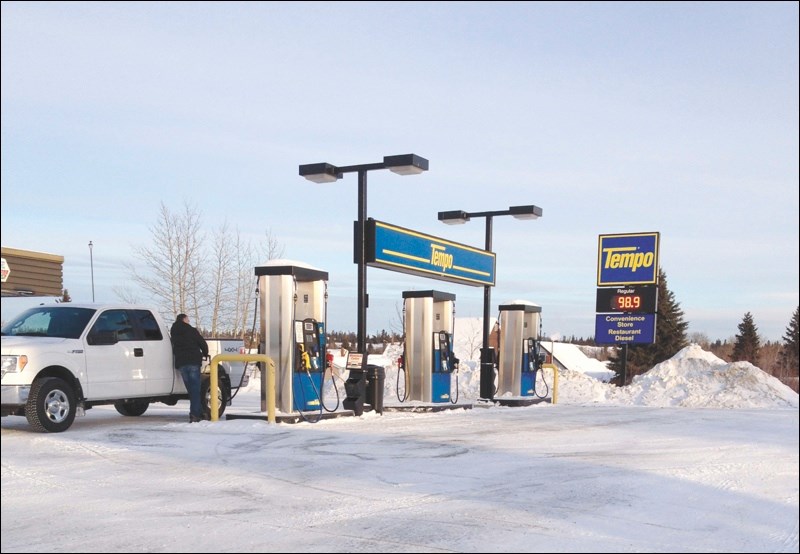The new year brought a gift for motorists as gas prices fell below $1 per litre in the area, the lowest level in five years.
“I think it’s great,” said Kim Petalik as he filled his truck at a Gateway gas pump New Year’s Day.
Across the country gas prices continue to drop, with the lowest average price logged in Edmonton AB, where a litre of gas averaged 77 cents, according to the website GasBuddy.com.
In Manitoba on New Year’s Day, the average price of regular gas was as low as 78.4 cents per litre in Winnipeg, while Regina and Saskatoon, SK., had average prices of 78.9 and 82.4 cents per litre, respectively.
In Flin Flon, gas was under $1 for self-serve stations, with Gateway and Creighton Service Centre both posting regular gas at 98.9 cents per litre, while Esso-Super K had a price of 99.9 cents per litre. The Gas Bar, which offers full service gas, was at 101.9 cents per litre.
Petalik said that while he’s glad that prices are lower, he still feels Flin Flon and area pay more than other areas for gas.
“I’m excited that it’s down, ecstatic,” he said, “but I wish it was more competitive.”
He pointed to The Pas for comparison, where gas prices ranged from 91.9 to 94.9 cents per litre on January 2.
The fall in gas prices is a trend that began in mid 2014, as global oil prices worldwide continue to plunge. A barrel of crude oil hit a 2014 high in June, selling for US$115. It dropped almost 50 per cent by the end of the year and at press time was priced under US$60.
While lower prices at the pump may be welcome for motorists, it has raised red flags for the economy. Huff Post Business named “Tanking oil prices” as one of the biggest risks to Canada’s economy in 2015 and beyond.
“The drop is a double-edged sword for the Canadian economy. The IMF (International Monetary Fund) says it could boost global economic growth by as much as 0.8 percentage points above the expected 3.8 per cent. It’s also good news for consumers, whose savings at the gas pump could translate into more spending elsewhere.
“However, if oil continues to hover between $60 to $70 [on December 30] a barrel, it could expose weaknesses in oil-dependent countries and companies and even push some to default on debt obligations. The tanking price is bad for Canada’s oilsands, a major source of domestic economic growth and could push the loonie lower.”
Consensus among economic news sources is that the balance between supply and demand is a major factor.
“The oil price is partly determined by actual supply and demand, and partly by expectation,” according to The Economist, which cites four conditions that are now affecting the picture.
“Demand is low because of weak economic activity, increased efficiency, and a growing switch away from oil to other fuels. Second, turmoil in Iraq and Libya—two big oil producers with nearly four million barrels a day combined—has not affected their output. The market is more sanguine about geopolitical risk. Thirdly, America has become the world’s largest oil producer. Though it does not export crude oil, it now imports much less, creating a lot of spare supply. Finally, the Saudis and their Gulf allies have decided not to sacrifice their own market share to restore the price.”
The Canadian Press also chose falling gas prices as its business news story of the year for 2014.
Average gas prices, past five years
Price per litre, regular gas at self service stations
Nov. 2010 Nov. 2011 Nov. 2012 Nov. 2013 Nov. 2014
Winnipeg 95.6 113.2 118.3 115.5 108.0
Regina 103.7 120.7 118.3 115.5 108.0
Saskatoon 100.1 117.9 121.0 113.2 108.3
Source: Statistics Canada




